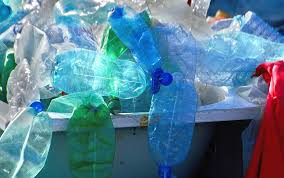
By Kathlean Wolf
Northside News
Last month was the 50th anniversary of Earth Day. It was also a month when many Northsiders noticed the litter left exposed when snow melted away, before plants grow up to cover our plastic debris once again. Yet with stay-at-home and social distancing directives in place, none of the usual Earth Day cleanup events took place in Warner Park, which bears the brunt of 1,200 acres of stormwater runoff and all the plastic trash that flows downstream with it.
One attempt to replace the Earth Day cleanup began in the Brentwood Neighborhood; the “Together-Apart Warner Park cleanup” project that ran from April 22‒26. Along the back of a baseball diamond opposite Calypso Street, 25 packaged cleanup kits were hung from the fencing, each containing a 50-gallon trash bag and four neoprene gloves. Neighbors interested in helping with the cleanup picked up the kit, then worked on their own or with their families to pick up trash in Castle Creek, the Old Warner Woods, the Monterey playground area, or other favorite areas of the park. Many took photos and shared them on social media to share their accomplishment.
By the end of the day April 26, well over 500 gallons of trash had been collected throughout the park. When members of the Madison City Parks Department carted the trash away Monday, they were especially appreciative of the efforts; during this pandemic, the work put in by volunteers may be the only chance to address a problem that city employees would usually work on as well.
As a Wisconsin Master Naturalist, I visit most areas of the park several times a year, including the rarely visited marshy areas that are impassable by canoe and nearly-impassable on foot. The plastic problem is larger than you’d imagine. On a sort of scavenger-hunt around Marsh Island, I collected over 100 plastic drink-bottles and 48 tennis balls. One ball was encapsulated in moss and tree-roots and had to be dug out, one was buried under a mound of muskrat poop (my sentiments exactly), and several had become integrated into the root systems of floating cattail mats.
Another, time, on a search for trace evidence of otters, my eye started to catch on every small piece of trash trapped in the moss and roots along the shoreline. It’s disturbing. I have yet to find a single square meter of land or water in Warner Park that is plastic-free. If it isn’t a floating bottle, it’s the oily sheen from “biodegradable” plastic leaching out into the water. If it isn’t a blown trash-bag, it’s the tiny white speckles of Styrofoam from an Amazon package, now glued into the soil forever by the reeds and grasses.
What would it take to deal with our plastic problem? When you’re at the bottom of a deep, dark hole, the first thing to do is stop digging. On the first day of the Warner Park Earth Day cleanup, I realized that I, too, contribute to the plastic drink bottle problem. It doesn’t matter whether I reuse the disposable drink bottle many times, or if I take the aluminum cans directly to the recycler; it’s the purchase of an unnecessary thing that contributes to the problem. We live in a country where clean water is nearly universally available (with some horrific exceptions). I can get caffeine without also buying “disposable” plastic.
The 500 gallons of trash removed from Castle Creek and other parts of Warner Park will make a difference to all the animals who will not be tempted to eat a brightly colored bottle cap or become trapped in a plastic bag. But when an average person in the United States generates 4 pounds of trash every single day, it’s a literal drop in the ocean.
The greater value comes when we all realize that there is no such thing as “away.” It isn’t “littering” that creates our plastic problem; it’s plastic that creates our plastic problem. From the overflowing trash cans at an apartment building where the landlord doesn’t want to deal with as many bins as are needed (and the residents are blamed for the resulting mess), to the neatly sorted triple-bins of compost, recycling and trash in more privileged areas, it’s all part of the same system. We live in a culture that requires us to buy plastic, use plastic and dump plastic, in incomprehensible quantities.
I’m supposed to come up with a positive ending to the story of the trash I see in Warner Park every day because that’s how I write. But there is no good ending to this story. I cannot foresee a day when I won’t walk into the park and see more plastic in the water and soil. We’re eating plastic, drinking plastic, even breathing it in. Between neoprene gloves, garbage bags, signs and rolls of tape on the signs, the project of cleaning up Castle Creek generated 7 pounds of plastic.
I’ll keep picking up trash. You and I will both keep buying more of it. And some of it will escape from trash bins, landfills, garbage trucks and the hands of inattentive children. In a few million years, sedimentary rock will have built up over our landfills, crushing and heating all of the plastic and other materials we’ve sequestered away as “trash,” and in the ultimate irony, it will be transformed into something resembling crude oil.